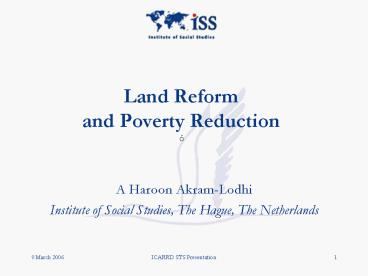Land Reform and Poverty Reduction - PowerPoint PPT Presentation
1 / 12
Title:
Land Reform and Poverty Reduction
Description:
The work was done for UNDP's Bureau of Development Policy. The investigation is both comparative ... Re-enclosure reconfigures a bifurcated' agrarian structure ... – PowerPoint PPT presentation
Number of Views:308
Avg rating:3.0/5.0
Title: Land Reform and Poverty Reduction
1
Land Reformand Poverty Reduction
ó
- A Haroon Akram-Lodhi
- Institute of Social Studies, The Hague, The
Netherlands
2
- The presentation investigates the land policies
of ten countries - Armenia
- Bolivia
- Brazil
- Egypt
- Ethiopia
- Namibia
- The Philippines
- Uzbekistan
- Vietnam
- Zimbabwe
- The work was done for UNDPs Bureau of
Development Policy - The investigation is both comparative and
analytical
3
- In the countries, there has been
- modest but significant achievements in
redistributive land reform in Brazil, the
Philippines and Zimbabwe - the establishment of peasant family farming in
Armenia and Vietnam - as a result of diverse strategies by state and
civil society actors - There has also been
- comparative stasis in Bolivia, Ethiopia and
Namibia - a comparative retreat from the gains of
redistributive land reform in Egypt and
Uzbekistan - again as a result of diverse strategies by state
and civil society actors
4
- Four comparative themes emerge
- 1. Neo-liberal globalization
- A previous emphasis on building the home market
has been replaced by the doctrines of comparative
advantage, international interdependence and a
level playing field
5
- This context has shaped the re-emergence of land
reform in the 21st century - the collapse of the Soviet Union
- the potential role of land reform in constructing
political stability, especially in South Africa - the need for access to land by agro-food
transnationals and local capitalists - the failure of neo-liberalism in developing and
transition economies - the lack of a supply response
- the rediscovery of the inverse relationship
- the need for private property rights
- the need to build markets
6
- 2. Land and agrarian production
- Barring Armenia and Ethiopia, processes of
neo-liberal re-enclosure of land are witnessed,
but subject to substantial differences - Re-enclosure reconfigures a bifurcated agrarian
structure - one sub-sector export oriented, more capital
intensive, with linkages to TNCs but less
extensive domestic forward and backward linkages - one sub-sector more diverse domestic production,
more labour intensive, with more extensive
forward and backward linkages, but not homogenous
7
- Three phenomena are witnessed
- expanded commodification
- to promote exports
- to promote productivity and profits
- de-agrarianization
- expanded privatization
- Thus, significant trajectories of variation
within similar processes of agrarian
transformation
8
- 3. Agrarian accumulation
- Export-driven
- Brazil and Vietnam asymmetrical but important
complimentary linkages between two production
sub-sectors - Bolivia, Egypt, Namibia, the Philippines,
Uzbekistan and Zimbabwe significantly weaker
linkages between two production sub-sectors - Deepening inequality in all 10 cases
- The impact of accumulation on poverty negligible,
with the exception of Vietnam
9
- 4. Rural politics
- The transformation of everyday politics into
collective action goes the furthest in Bolivia,
Brazil and the Philippines, although elsewhere
collective action does take place - The character of the rural elite differs in these
3 cases - The role of the state differs in these 3 cases
10
- Thus the 10 case studies demonstrate a set of
common themes, in that neo-liberal re-enclosure
alters rural production, affects accumulation,
and politics - The common themes are embedded within substantive
diversity and differential trajectories of
variation
11
- Thus, we have a perspective on the role of
agriculture in modern economic development that
emerges from the comparative analysis - transnational capital dominates the reshaping of
world agriculture in an era of neo-liberal
globalization - within this, national differences still matter
- the resolution of the constraints to agrarian
development in large developing and transition
economies would facilitate increased global
accumulation - In many small developing and transition
economies, transnational capital does not care
about the rural economy, but there remain stark
contradictions between local capital, the state
and peasant classes that can only be resolved by
developing the productive forces
12
- Thus, internal and international dynamics
interact to promote the global deepening of
capitalist relations of production even as
national specificsincluding the possibility of
disarticulated developmentremain - The development of the forces and relations of
production are shaped by and shape each other,
and, in this interactive process, the critical
variable is the balance of forces, locally,
nationally, and internationally, between capital
and labour































